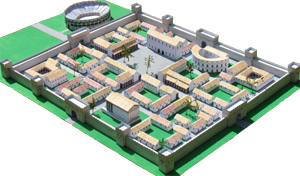
Themes: towns, soldiers and metal art.
New option: A day just on Celtic art
Pick 2 out of 3 sessions to make a full day.
Main activities (follow links for full details):
1. Learn about Roman towns from photos, plus game
2. Make a Roman town from card
1. Learn about Roman soldiers and their gear from pictures and replicas
2. Make Roman swords and helmets
1. Learn about Roman and Celtic metal art from photos and replicas
2. Make Roman and Celtic foil art or Celtic torcs (see options below)
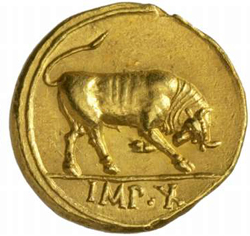
Gold Roman coin which children can make a copy of in the metal art activity
Suitable for Year 4-6
The activities are challenging, but are suitable for most year 4s. However at least 2 extra adults will be needed to help - see below for more details.
To Book
Email Tony North: tnorth67@hotmail.com or tel: 07754 406422 or 0161 224 6445
Fee: £329 per class for a whole day Max. 32 children.
Introduction to the Workshop
In the Romans in Britain workshop children are challenged to create artefacts using high quality materials and methods. They learn about the lives of the Romans and Celts through enjoyable and educational activities, and produce artwork you can proudly display.
Photos from workshops:
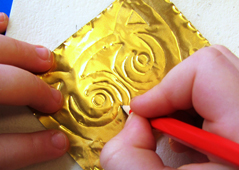
My Italy photos, 2013 - photos of Rome, Naples, Pompeii, Herculaneum, Ostia, and more
Background
info on the artefacts
Teachers' comments:
"thoroughly
enjoyable with great outcomes" (click for more reviews)
For sale at workshops: Roman carvings (unpainted), £2 (see below).

Roman town children make in the workshop
Background: The Romans in Britain
In 55BC Julius Caesar led his troops across the English channel in a first attack on the Britons. Despite several victories he abandoned a full scale invasion. It was not until almost 100 years later, in AD43, that Roman legionaries under orders from Emperor Claudius returned. This time they stayed, for 400 years, conquering almost the whole island.
The Romans brought with them a wide variety of arts and crafts, which over time were adopted by the Celts. However, the influence was in both directions, for the Romans were open to new ideas and new styles, and a mingling of Roman and Celtic arts and culture occurred.
Roman rule had a profound impact on the lives of the Britons. The first true towns were built, on a pattern repeated throughout the Roman world, with well-constructed stone roads and walls, villas, temples, amphitheatres, shops, forums, and baths. The Celts had never experienced anything like it.
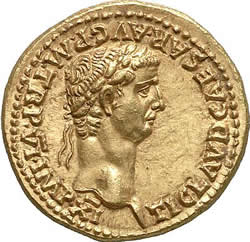
Coin of the Emperor Claudius, who ordered the invasion of Britain in AD43
Lesson Plan: Towns
1. Roman Towns & game (30 mins)
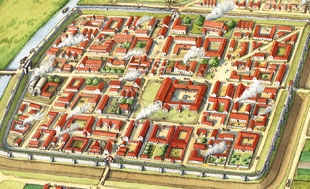
Look at photos of real Roman buildings and discuss: houses, villas, shops, forum, theatre, amphitheatre, baths, temple, and city walls and gates.

Amphitheatre at Caerleon, S.Wales
Discuss what life might have been like for someone living in a Roman town. How similar would it be to life in a town today?
Game: look at photos of buildings from the Roman empire and guess what sort of building they are.
Another 'name the building' game
Before break we will set out the materials for the town making.
2. Make a Roman Town (90+ mins)
click to see larger version
Children make a model of a Roman town, by cutting out card 'nets' and folding and sticking them together. Different groups of children make the sorts of buildings discussed earlier (except for baths which are very complicated shapes). Two town planners paint a street grid on a piece of hardboard (approx 60X90cm), and decide where each building will go, thinking about ideal locations.
The town is a large and complex activity and it is unlikely the class will finish it by lunchtime.They will continue to work on it in the afternoon after making their artefact (weapon/armour or mosaic).

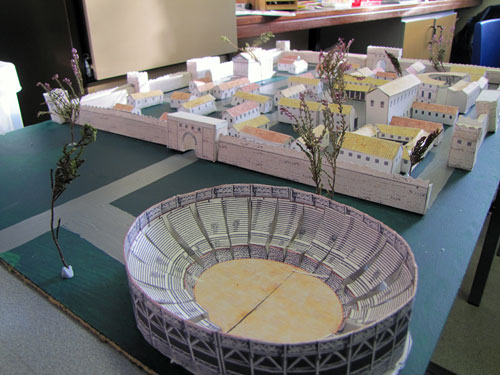
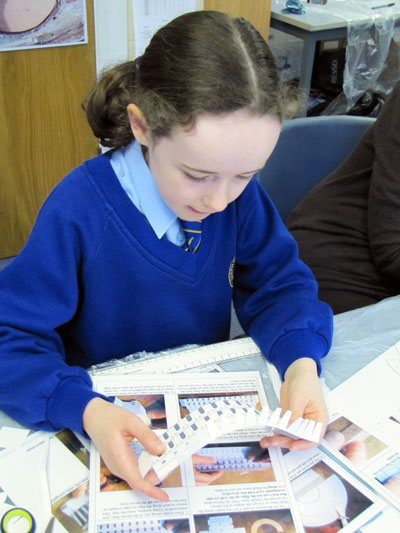
Please note that the town making requires complex skills such as cutting, folding and gluing accurately, as well as following written instructions. This means the workshop will be too hard for some year 4s. If you are in doubt, I recommend the mosaic and metal art option. For all options, we will need at least 2 extra adults in to help the children. If this is not possible we will make a reduced range of items for the town and metal art.
To help prepare children for the town making you can do two things:
1. Practice some of the art skills in advance, especially scoring with scissors and ruler, and making 3D shapes from nets.
2. On the day of the workshop, have as many adults as possible in the class
to help (for both the morning and afternoon). You could invite parents in if TAs are in short supply.
Please note that if fewer than 3 adults (in addition to
myself) are present we will omit the more difficult buildings when
making the town (the temple, theatre and amphitheatre). I can leave the
resources for children to make these buildings another day if you wish.
Torc made
at St. Richard's RC Primary, Manchester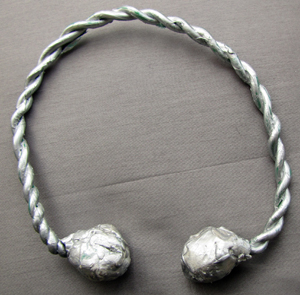
Lesson Plan: Soldiers
1. Learn about Roman Soldiers (20-30 mins)

Roman legionary
We begin by learning about Roman soldiers and their gear through photos and my replicas. Children see my Roman sword (gladius) and sheath, spear (pilum), shield (scutum), helmet (galea), body armour (lorica segmentata), belt (cingulum) and dagger (pugio). I show them how these items would be used in combat, and we discuss the life of a Roman soldier. One child can then be selected to wear/hold all this gear - a great photo opportunity!

Roman gladius and sheath, seen in the workshop
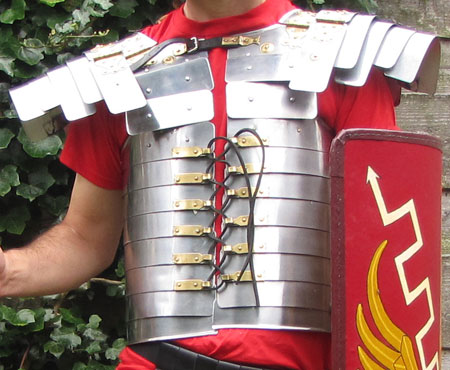
Me with my lorica segmentata and shield
My helmet replica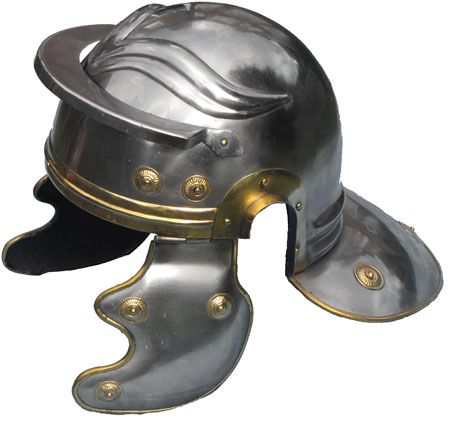
2. Make Swords and Helmets (100 mins)
Next children make Roman swords or helmets. I have designed these as high quality arts and craft activities, and I provide most of the resources. Most children will make a sword; a few more talented children can make a helmet.
Children use silver and gold card, wooden handles, plastic balls, plasticine and paint to create realistic models, following my guidance and support.
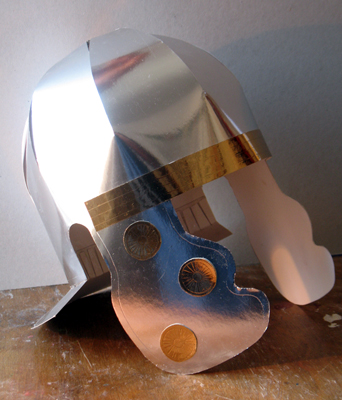
The helmet made by some of the children
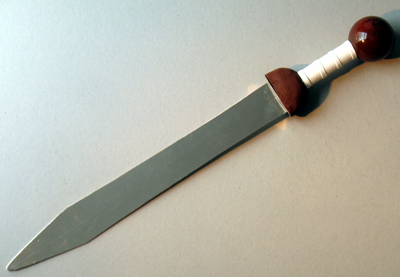
The sword most of the children will make
Lesson Plan: Roman and Celtic Metal Art
1. Look at Roman and Celtic Metal Art (30 mins)
Children see replicas of Roman and Celtic artefacts, and discuss what they are (function/use), who might have used them, what they are made of, and their artistic style (Roman art is realistic, Celtic art features curves, circles and less realistic representations of animals and people). I also show photos of real artefacts on the whiteboard.

Artefacts seen: Celtic torc, mirror, and shield, two Roman embossed silver plates (one is a copy of a plate from the Mildenhall treasure - see above, and the other is a copy of part of the Corbridge lanx showing goddesses), and real Roman coins. Children will also see my versions of the items they will make from foil. Click here to see these copies.
Art activity options
1. Foil Art: Each child makes two items of foil art - first a silver item and then a gold item. If you prefer, the items can be only Roman, only Celtic, or a mixture of both. This is the default option: that is, unless you specify you want to make torcs, we will make foil art.
3. Torcs: If your focus is on the Celts, you can have each child make their own torc (they make them in pairs, but each pair makes two torcs).
If you want a day only on Celtic art, we can make a torc for each child in the morning and a Celtic foil item for each in the afternoon. As an introduction I will do a short lesson on the Celts and their art styles and show my Celtic artefact copies.
2. Make Embossed Metal Art (60 mins)
The children make beautiful items of metal art using gold and silver foil, specially designed for embossing.
Click here to see all the items as well as the originals on which they are based.
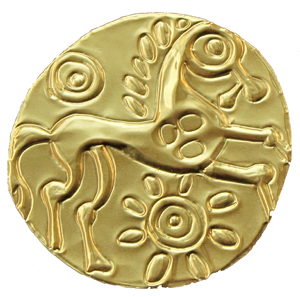
Copy of Celtic coin children will make
Using a pen, children trace over lines on a printed template onto the foil underneath. They then emboss the lines to make them stand out clearly, using a sharp pencil and a soft mat. Finally they cut out the foil and glue it to a card backing to protect it.
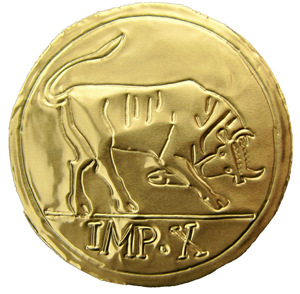
Copy of Roman coin which children will make
As the foil is very easy to damage, children with difficulties in tracing over lines will use gold and silver card instead of foil. The card is still very effective, and they can make several different items as it is easier, quicker, and less costly.
Look at metal art made by children in workshops
3. Make Torcs (45 mins)

The Great Torc from Snettisham
For the alternative activity, children work in pairs to make two Celtic torcs. This is a necklace made from twisted metal, often worn by elite Celtic warriors. The pairs hold a loop of garden wire with sticks and twist. They add plasticine for the ends, shape the wire into a circle, engrave the plasticine with a pencil and paint the torc gold or silver.

Torc made by Y4 children at St. Joseph's RC Primary
Game - can you tell if an artefact is Roman or Celtic?
Another 'Roman or Celtic?' game


